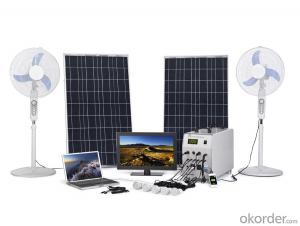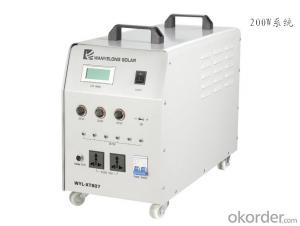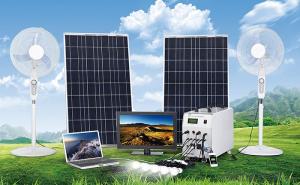Solar Power System - AC >200W Solar Power System
- Loading Port:
- Guangzhou
- Payment Terms:
- TT OR LC
- Min Order Qty:
- 20 set
- Supply Capability:
- 10000 set/month
OKorder Service Pledge
OKorder Financial Service
You Might Also Like
Light up 4-6 rooms at the same time,with mobile phone charge function,power DC fan,DC TV,Laptop,AC TV,Computer
●Installation,all-in-one DIY Kit;
●5m light cable-with on/off switch;
●Mobile phone charge-for different phones;
●Power Supply-solar or AC adapter;
●Protection-overcharge and over-discharge;
●Pure sine wave inverter built in.
Part | Specification | Qty | |
Solar panel | Poly crystallione type with 10m cable | 100W | ×1 |
Power box | Lead acid rechargeable battery | 55AH/12V | ×1 |
PWM charge controller | 10A/12V | ×1 | |
Pure sine wave inverter | 300W | ×1 | |
AC Output | 220V/110V 50/60Hz | ×1 | |
Cigarette lighter socket output | DC12V | ×2 | |
DC output port | 12V | ×4 | |
USB charge output | 5V | ×1 | |
Others | DC12V LED bulb | 3W | ×4 |
Light holder with 5m cable | On off switch | ×4 | |
USB charge cable | 10 in 1 | ×1 | |
Solar panel mounting bracket | Angle adjustable | ||
DC floor fan (not included) | 15W/12V | ×2 | |
DC TV (not included) | 15inch 30W12V | ×1 | |
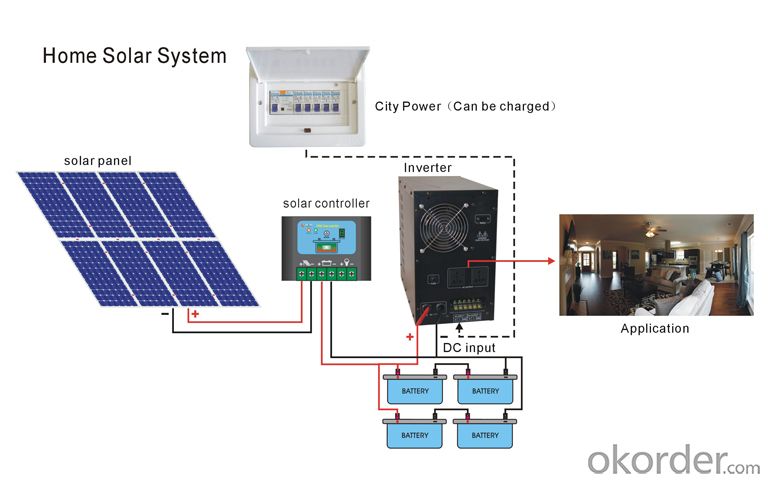
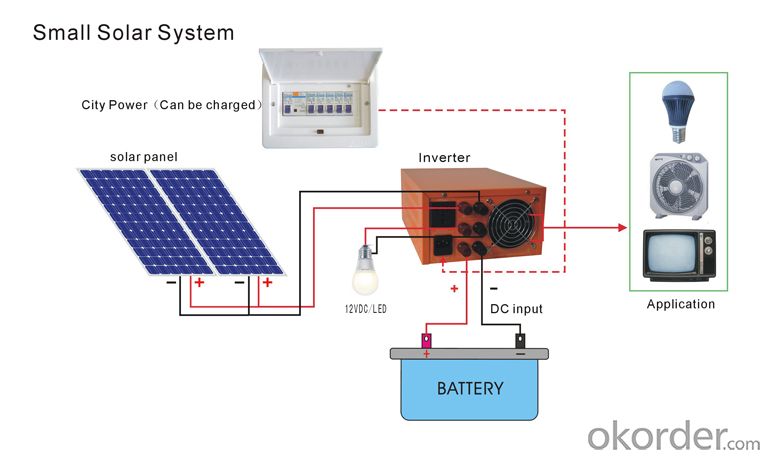
Quantuty
Quality goal:Constant innovation to meet the request of the customers. Protect the environment, provide environmental products to customer.
Quality strategy:
Quality: established high efficiency quality manager system in line with ISO9001 and ISO/TS16949.
Improvement: keeping improvement & quality guarantee.
Efficiency: delivery on time, complete the agreed events with the customers on time.
Service: focus on customers, provide the service and technology support on time.
FAQ
1. How long will my inquiry get response?
Your inquiry related to our products or prices will be replied within 24 hours.
2. Can I get professional service and suggestion?
Well-trained and experienced staffs to answer all your questions in fluent English.
3. Do you accept OEM or customized design?
OEM & ODM, any your customized lightings we can help you to design and put into product.
4. What if I need specific design?
Distributorship are offered for your unique design and some our current models.
- Q:Can solar energy systems be used in areas with strict building codes or historical preservation restrictions?
- Indeed, it is possible to utilize solar energy systems in areas that have stringent building codes or restrictions on historical preservation. Although it may necessitate additional considerations and careful planning, integrating solar energy systems into the existing structures is certainly achievable. One approach to incorporating solar energy systems involves employing building-integrated photovoltaics (BIPV) or solar thermal systems that flawlessly blend into the building's design. These systems can be installed on rooftops, facades, or even utilized as shading elements, ensuring that the building's historical aesthetics or architectural integrity remain intact. Additionally, advancements in solar technology have facilitated the creation of more visually appealing solar panels, such as solar tiles or transparent solar windows, which harmonize with the building's existing materials. This simplifies the process of obtaining approval from historical preservation boards or building code authorities. It is crucial to note that in areas with strict building codes or historical preservation restrictions, the approval process for installing solar energy systems may be more complex. It may entail acquiring permits, conducting structural assessments, and closely collaborating with local authorities to ensure compliance with regulations. Nevertheless, due to the increasing recognition of the significance of renewable energy, many jurisdictions have established specific guidelines and provisions for integrating solar systems in historic areas. To summarize, it is feasible to utilize solar energy systems in areas with strict building codes or historical preservation restrictions by employing BIPV, solar thermal systems, or visually appealing solar panels. Although the approval process may require more effort, with proper planning and adherence to guidelines, it is possible to harness solar energy without compromising the architectural or historical significance of the area.
- Q:Can solar energy systems be used in areas with high temperatures?
- Yes, solar energy systems can be used in areas with high temperatures. In fact, solar panels are designed to withstand and operate efficiently in a wide range of temperatures. While high temperatures can slightly affect the efficiency of solar panels, modern technologies and materials have been developed to minimize any negative impact. Additionally, solar energy systems can be optimized through proper installation and maintenance to ensure maximum performance in hot climates.
- Q:What are the different financing options for solar energy systems?
- There are several financing options available for solar energy systems, including cash purchases, solar loans, solar leases, power purchase agreements (PPAs), and property assessed clean energy (PACE) financing. Cash purchases involve paying the full cost of the system upfront. Solar loans allow homeowners to borrow money to finance the system and pay it back over time with interest. Solar leases involve leasing the system from a third-party provider and paying a fixed monthly fee. PPAs allow homeowners to purchase the electricity generated by the system at a predetermined rate. PACE financing allows homeowners to finance the system through an additional assessment on their property taxes.
- Q:Can solar energy systems be used in areas with limited access to sanitation facilities?
- Yes, solar energy systems can be used in areas with limited access to sanitation facilities. Solar energy systems can provide electricity to power sanitation facilities such as water pumps, filtration systems, and waste treatment processes, helping to improve sanitation conditions in these areas. Additionally, solar-powered systems can also be used to generate heat for water heating, further supporting sanitation practices.
- Q:Can a solar energy system be installed in an area with high wind speeds?
- In areas with high wind speeds, it is possible to install a solar energy system. However, it is necessary to consider certain factors and take precautions during the installation process. To ensure that the solar panels can withstand strong winds, it is important to select panels specifically designed for this purpose and securely anchor them. Additionally, the support structures such as mounting racks or frames should be firmly fastened to ensure stability. Professional installers who have experience working in high wind areas can design and install the system in a manner that prioritizes safety and efficiency. It may also be necessary to adjust the orientation and angle of the solar panels to minimize wind resistance and potential damage. Through careful planning and installation, solar energy systems can be successfully implemented in areas with high wind speeds, effectively harnessing the power of the sun despite challenging environmental conditions.
- Q:What is the role of solar energy systems in achieving energy independence?
- Solar energy systems play a critical role in achieving energy independence by harnessing the power of the sun to generate clean and renewable electricity. They contribute to reducing reliance on fossil fuels, decreasing greenhouse gas emissions, and diversifying the energy mix. Solar energy systems allow individuals, communities, and even entire nations to generate their own electricity, reducing the need for importing energy from other sources. By promoting energy self-sufficiency, solar power systems contribute to greater energy independence and sustainability.
- Q:Can solar energy systems be used in disaster-prone areas?
- Yes, solar energy systems can be used in disaster-prone areas. In fact, they can prove to be extremely beneficial in these areas. Solar energy systems are resilient and can continue to function even during power outages caused by natural disasters. They provide a reliable and sustainable source of electricity, which can be crucial for emergency response efforts, powering communication systems, medical equipment, and providing lighting and heating. Additionally, solar energy systems can help reduce dependence on fossil fuels, contributing to a more sustainable and environmentally-friendly recovery and rebuilding process.
- Q:Can solar energy systems be used for powering electric vehicle wireless charging systems?
- Indeed, electric vehicle wireless charging systems can be powered by solar energy systems. These solar energy systems, such as solar panels, have the capability to capture sunlight and convert it into electricity. This electricity can then be utilized to power a wide range of devices and systems, including electric vehicle wireless charging systems. The process of utilizing solar panels to charge electric vehicles wirelessly involves the installation of these panels on either a building or a dedicated solar carport. Once the solar panels are in place, they are able to gather sunlight, which is subsequently transformed into electricity. This electricity can be stored in batteries or directly supplied to the charging system. The utilization of solar-powered wireless charging systems presents numerous advantages. Firstly, it provides a sustainable and renewable energy source, reducing the reliance on fossil fuels. Consequently, this contributes to the creation of a cleaner and more environmentally friendly atmosphere, as solar energy is a clean and emission-free power source. Secondly, solar-powered charging systems can be installed in remote areas where access to the power grid may be limited. This allows for the convenient charging of electric vehicles in locations that lack traditional infrastructure. Furthermore, solar energy systems have the potential to decrease the overall energy expenses associated with charging electric vehicles. By harnessing the power of the sun, electric vehicle owners can benefit from lower operational costs and even have the opportunity to earn money by selling any excess energy back to the grid. In conclusion, it is evident that solar energy systems can undoubtedly be utilized to power electric vehicle wireless charging systems. These systems offer a sustainable, renewable, and economically viable solution for charging electric vehicles, all while reducing the environmental impact and promoting energy independence.
- Q:What is the difference between a microinverter and a string inverter in a solar energy system?
- A microinverter is a small inverter that is installed on each individual solar panel in a solar energy system. It converts the DC electricity produced by each panel into AC electricity, allowing for independent optimization of each panel's performance. On the other hand, a string inverter is a larger inverter that is typically connected to multiple solar panels in a series, converting the combined DC electricity from all the panels into AC electricity. The main difference between the two is that microinverters offer panel-level monitoring and optimization, while string inverters offer system-level monitoring and optimization.
- Q:Can solar energy systems be used for powering electric vehicle solar charging garages?
- Certainly, electric vehicle (EV) solar charging garages can indeed utilize solar energy systems. In reality, incorporating solar power into these garages presents a remarkable opportunity to endorse sustainability and diminish carbon emissions. Sunlight can be harnessed and transformed into electricity by installing solar panels on the garage roof or nearby. Consequently, this electricity can be employed to operate the charging stations, delivering clean and renewable energy for EVs. By integrating solar energy systems into charging garages, it becomes feasible to establish a self-sufficient and eco-friendly ecosystem for EV owners.
1. Manufacturer Overview |
|
|---|---|
| Location | |
| Year Established | |
| Annual Output Value | |
| Main Markets | |
| Company Certifications | |
2. Manufacturer Certificates |
|
|---|---|
| a) Certification Name | |
| Range | |
| Reference | |
| Validity Period | |
3. Manufacturer Capability |
|
|---|---|
| a)Trade Capacity | |
| Nearest Port | |
| Export Percentage | |
| No.of Employees in Trade Department | |
| Language Spoken: | |
| b)Factory Information | |
| Factory Size: | |
| No. of Production Lines | |
| Contract Manufacturing | |
| Product Price Range | |
Send your message to us
Solar Power System - AC >200W Solar Power System
- Loading Port:
- Guangzhou
- Payment Terms:
- TT OR LC
- Min Order Qty:
- 20 set
- Supply Capability:
- 10000 set/month
OKorder Service Pledge
OKorder Financial Service
Similar products
New products
Hot products
Related keywords
